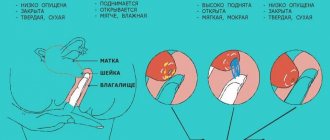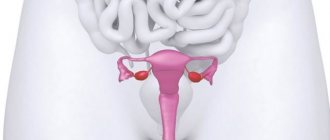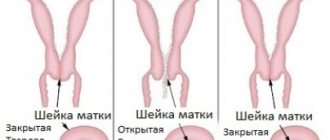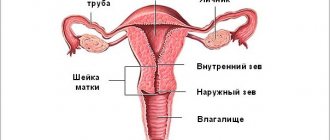The position of the cervix after ovulation is one of the parameters that allows you to determine the phase of the menstrual cycle suitable for conception. Independent study of changes in the position of the cervix of the main female reproductive organ will help you understand how long ago ovulation took place, or when you should expect it next time.
Advice!
If a girl does not have the opportunity to regularly visit a gynecologist, but is interested in accurately determining the day of ovulation, she is able to independently conduct a study of the changes that occur in her uterus. To do this, it is enough to regularly palpate the cervix over several successive cycles.
During ovulation, it will be quite soft to the touch, but reaching it, due to its physiological position, will not be easy. By touch it will be possible to determine how well the uterus is open at a certain point in time. The ideal position for such independent research is lying on your back with your knees well bent.
What is the physiological position of the cervix before ovulation?
Immediately after a woman ends her period, she enters the initial phase of the next cycle. Palpation at this time is most simple, since the position of the cervix is as low as possible. Immediately after penetrating the vagina with a finger, the cervix will be felt under the pad, which has a dense structure in the first days of the cycle. Many gynecologists, based on tactile sensations, compare such a cervix with the tip of the nose.
The throat of the cervix at this time is tightly closed, since the woman’s body at this time is completely unprepared for pregnancy. Closing the pharynx prevents the free penetration of sperm, as well as various pathogenic flora, which can provoke inflammatory diseases that can further affect the ability to conceive.
Discharge before ovulation
The cervical canal can be filled with two types of discharge:
- fertile (optimal environment for sperm, have viscous properties);
- infertile (a destructive environment for male reproductive cells; when trying to stretch, they break off).
Before the egg is released from the ovary, the nature of the cervical discharge changes. After menstruation, the canal is filled with a cloudy sticky suspension - infertile mucus. And just before ovulation, the discharge changes its character, preparing to receive “tailed” guests and to conceive a new life.
How do you understand that the nature of the mucus has changed and ovulation will soon occur?
Observe your discharge. If you have a persistent feeling of something leaking from the genital tract, your daily routine is constantly wet, and the discharge itself is transparent and liquid, it means that ovulation is just around the corner.
Typically, the release of discharge is accompanied by mild aching pain from the ovulating ovary.
Why is mucus necessary?
Mucous secretions are a favorable microflora for sperm, which not only helps them survive outside the male body, but also reach their intended goal - the egg.
Changes in the cervix immediately during ovulation
Before the egg leaves the ovary in which it matured, certain physiological changes occur in the body of every woman. The symptoms of such changes are similar for all representatives of the fair sex. Painful sensations experienced by a woman in the pelvic area are harbingers of ovulation.
The change in the position of the cervix before ovulation is due to the action of hormones that prepare the female body for the possibility that conception may soon occur. Slowly shifting, this part of the organ gradually rises into the vagina. On the day of the cycle when the egg leaves the ovary, its maximum point can be observed. When palpating, it is almost impossible to reach the cervix when it is in this position.
Additional symptoms that are precursors of ovulation accompanying cervical displacement:
- the appearance of mucous vaginal discharge;
- rapid increase in basal temperature;
- increased sensitivity of the mammary glands;
- increased libido levels, which is due to the active effect of female sex hormones on the body.
It is noteworthy that very young girls may not have any noticeable symptoms.
Other signs
What other signs can hint you at upcoming ovulation?
- tingling in the side (in the ovary area);
- nipples become sensitive, slight breast enlargement may occur;
- basal temperature rises;
- the nature of saliva changes (crystallizes);
- slight bleeding is observed;
- my back aches and hurts.
Why does the stomach feel tight during ovulation?
One of the reasons for heaviness in the abdomen is the rupture of the follicle and the release of the egg. In this case, aching pain is considered normal. If such pain is observed a certain time after the release of the egg, then this may indicate the development of an ectopic pregnancy. How dangerous this condition is, and how to recognize it, can be read in the article: “ Threat to life during ectopic pregnancy.”
What happens to the cervix after ovulation
After the favorable time for conception has passed, changes continue to occur in the organ due to hormones that prepare the woman for menstruation. The throat of the cervix gradually begins to close, and its structure becomes very elastic and quite dry to the touch. The position at this stage of the cycle is between ovulatory and preovulatory. At the moment when a woman’s body understands that pregnancy has not occurred, the throat opens slightly so that menstrual blood and the endometrium rejected by the uterus do not have barriers to excretion from the body.
Palpation at home
Many women, before going to the doctor, would like to confirm or refute their assumptions about a possible pregnancy. Knowing the basic characteristics, there is a chance to determine the development of a new life at home before the delay. The uterus is soft during pregnancy. But in women who have not given birth, the cervix is tightly closed and located high. Before menstruation, its position is lower.
Even an experienced specialist would not risk diagnosing pregnancy solely on the basis of an examination.
Palpation technique
This method is used only if it is impossible to visit a doctor often. It should not be used before menstruation to avoid infection. When deciding to use this technique, you need to remember its disadvantages.
If you want to carry out an inspection on your own, you must follow a number of recommendations:
- Before palpation, it is necessary to cut the nails on the middle and index fingers.
- Wash your hands thoroughly and wear sterile gloves.
- Two fingers are inserted deep inside.
- The tubercle inside should be palpated and conclusions drawn about the condition of the cervix.
Disadvantages of self-palpation
There are a number of negative qualities of the presented diagnostics. These include the following facts:
- There is a possibility of infection and causing various diseases.
- If you accidentally move it inaccurately, there is a risk of injuring the neck, which will cause erosion.
- It is impossible to determine with a high degree of probability whether pregnancy has occurred.
- You will still need to see a medical specialist.
Self-diagnosis is considered a rather risky approach. Even having sufficient theoretical and practical experience on this issue, it is almost impossible to draw accurate conclusions about the state of the reproductive system based on palpation at home.
Only a proper examination by a qualified specialist will be an adequate means of determining pregnancy.
Over the course of a month, all organs and mucous membranes in a woman’s reproductive system undergo a physiological transformation. You can see what the cervix is like before menstruation or after conception only with the help of medical equipment. At home, at best, you can feel her entrance from the vagina to determine the stage of the cycle. A visual examination by a gynecologist is, of course, a more informative method of diagnosis.
During menstruation, the endometrium is shed and comes out with blood. Then a new layer of mucous membrane grows inside the uterus, and the egg matures in the ovaries. After ovulation, the 2nd half of the cycle begins. During this period, a temporary gland is formed in the ruptured follicle - the corpus luteum. It produces the motherhood hormone progesterone. If conception does not occur, the corpus luteum dies and preparations for a new cycle begin.
You can reach the cervix with your middle finger by inserting it into the vagina. At the end, a slippery tubercle with a diameter of up to 3 cm with a hole in the middle is felt - the external pharynx. This is the external entrance of the cervical canal. The organ is designed to drain blood, cervical fluid, sperm and other secretions from the uterus, as well as barrier protection against infections from the vagina.
Condition of the uterus in case of fertilization
If conception does occur and the woman is pregnant, the organ, which over the next nine months will serve as the habitat of her unborn child, begins to change in a certain way. The position of the cervix in this situation will be the same as during ovulation, but the pharynx will be tightly closed. This is necessary so that during the process of bearing a child, pathogenic microflora from the external environment does not enter the uterine cavity.
Advice!
You should not try to diagnose pregnancy on your own, based only on an independent examination of the position and structure of the cervix. Especially if a woman does this for the first time. In order to make sure that conception has actually occurred, it is important to visit a gynecologist who will conduct a professional examination, prescribe an ultrasound or hormonal blood tests if we are talking about early pregnancy.
How to conduct research?
- To correctly determine the position and degree of opening of the cervix, you need experience of at least two or three cycles; only with practice, you will learn to distinguish a low position from a high one, a closed state from an open state, and a hard state from a soft one.
- You need to start research after the end of menstruation, once a day is enough, preferably at the same time. Of course, you cannot carry out manipulations with vaginal infections or inflammation of the genital organs.
- First, wash your hands thoroughly. Then take one of the suggested positions in which the cervix is most accessible:
- Squatting;
- Sitting on the toilet;
- Place one foot on the edge of the toilet or bathtub.
The position should always be the same. Use your index or middle finger as a “measuring device.”
Should you be concerned about pain in the pelvic area, where the uterus is located?
Most often, painful sensations in the lower abdomen are quite physiological for a woman, as they accompany certain phases of the menstrual cycle. They have a spastic nature, so they can be neutralized with the help of any antispasmodic that comes to hand, or special drugs designed exclusively to eliminate women’s pain.
Sometimes there are situations in which pain in the uterine area is a manifestation of some pathology. Many girls and women tend not to pay any attention to it, turning to a doctor only when the problem goes too far. It is imperative to visit a gynecologist if the following symptoms are observed:
- The pain in the lower abdomen is so severe that it can hardly be relieved by painkillers, and it is difficult to bear even in a horizontal position of the body with the pelvic muscles completely relaxed.
- Spasms that provoke fainting.
- Fever.
- Problems with stool - diarrhea, severe nausea, regular vomiting.
- Tachycardia.
- Dizziness.
- Painful sensations during urination.
More about menstruation
The premenstrual period is characterized by certain changes in the female body and reproductive system.
Before menstruation, the cervix drops, its edges become loose, and it itself is soft and slightly open. All practicing gynecologists know exactly how the cervix should correspond to a certain period of the menstrual cycle. Shortly before menstruation, a woman’s body prepares to reject the old uterine epithelium and blood fibers, which is why the cervix smoothes out a little and opens slightly, allowing all secretions to leave the uterus. Thus, a complete menstrual cycle passes, and after the completion of menstruation and the ovulation period, menstruation begins again.
Before menstruation, the cervix becomes loose and soft to the touch. It descends lower and slightly misses the tip of the finger (in women who have given birth this is more pronounced). That is why during menstruation you need to be especially careful about personal hygiene, use natural, comfortable underwear and regularly change your sanitary pad or tampon.
When the cervix is slightly open, there is a possibility of infections being introduced inside, which can cause the development of dangerous diseases or inflammation of the genital organs, which can subsequently cause adhesions in the fallopian tubes and lead to infertility.
During pregnancy, the cervix rises as high as possible in the vagina; upon examination, it can only be felt with a fingertip. It will be very hard and dense, and the hole will look like a small flat slit. Knowing what the cervix is like before menstruation, you can compare whether it is prepared for the start of the cycle.
During pregnancy, the length of the cervix also increases (becomes more than 2.5 cm). If it begins to decrease before the appointed time, it means that the risk of premature birth or spontaneous abortion increases.
During pregnancy, an examination allows you to determine the likelihood of a miscarriage, since the cervix during this period should be long and dense, but if its length becomes less than 2.5 cm, the doctor should prescribe additional examinations or hospitalization of the pregnant woman to prevent premature birth or miscarriage.
Shortly before childbirth, examination of the cervix allows you to determine the readiness of a woman’s birth canal for the start of labor. At this time, the neck should be shortened, smoothed and allow 1-2 fingers into the pharynx.
The cervix before menstruation and during pregnancy has its own characteristics that allow doctors to determine a woman’s condition without conducting additional examinations, if they are not currently possible. The doctor can make a final conclusion only after a complete examination of the body.
Every month there is a complex interaction between the pituitary gland in the brain, the ovaries and the uterus. Signals caused by hormones are sent throughout the body to prepare it for a possible pregnancy. An egg is produced, the lining of the uterus thickens, and hormones prepare the vagina and cervix to receive and support sperm.
After menstruation, the inner lining begins to grow again to become a thick, loose “nest” in preparation for a possible pregnancy. On day 14-15 (for most women), one of your ovaries will release an egg that will eventually enter your fallopian tube (called ovulation).
Before the egg matures, the cervix rises slightly, becomes softer and opens slightly. A woman can feel these signs of ovulation herself, not excluding clear mucous discharge. Immediately at the moment of ovulation, the female organ becomes even more loose, and the canal, accordingly, opens wider.
This creates favorable conditions for the passage of sperm. If conception does not occur, after a few days the body prepares for menstruation. At this point, the cervix becomes firmer and more elastic, and the cervical canal, in turn, closes. About a day before menstruation, the position of the uterus changes from slightly elevated to lowered, and the elastic cervix softens.
Below in the photo is the cervix before menstruation. It becomes hard to the touch in a few days.
There are three changes you feel when you check your cervix. First, the position of the cervix is high, medium or low. As you approach ovulation, the cervix moves up and back. It may be so high that you cannot reach it.
The article presents a photo of the uterus. To the touch before menstruation, it has a dense structure.
Estrogen softens the tissue of the cervix, making it softer when the body is most ready to conceive. Some say it feels a bit like the tip of your nose when you are “not fertile,” and like the hardness of your lips when you are “fertile.”
Open or closed? The cervix will be slightly open shortly before ovulation. The hole is tiny - no more than a thin slit. It will open again just before and during your period. However, during this period the cervix will be lower (not higher as before ovulation).
Above is a model (photo) of the cervix. Before menstruation, the organ becomes hard to the touch.
If the cervix is always slightly open, don't worry. Especially if you have ever given birth (which may include a miscarriage). The hole simply cannot close completely. As you approach ovulation, you may still notice a change in the height and softness of your cervix.
A cervix that is high, soft and open is fertile. Low, hard and closed are not fertile characteristics and you are probably not ovulating yet or have already ovulated.
In this case, the cervix is in the most elevated position in the vagina, and you can only feel it with your fingertip. During this period, the organ is dense, hard, and the canal takes on the appearance of a small flat slit.
A woman immediately knows that ovulation is approaching. There are several main components for an accurate diagnosis, namely, the cervix rises, the canal opens a little and softens. In addition, sticky discharge appears. When the days most likely for conception arrive, the cervix is high, reaches a loose consistency, and the canal opens even more for better penetration of sperm.
These days, upon independent examination, women notice increased humidity in the cervical canal, and the entire surface of the uterus, upon deep palpation, is soft.
To properly visualize the picture, let’s create an analogy: with dry soil, not enriched with useful substances and water, it is impossible to even plant a seed. Something similar happens in the female body recently before menstruation.
After the time of ovulation has safely passed and fertilization has not occurred, the female genital organs begin to prepare for menstruation. This happens approximately on the 16-17th day of the menstrual cycle. The cervical canal quickly closes, the level of location drops, and the structure of the tissue changes to the touch - hard, elastic.
Thus, the time after ovulation or the body’s preparation for menstruation is characterized by a “closed,” hard, elastic, dry cervical canal. Unfavorable time for “reception” of sperm and fertilization.
The uterus is an important female reproductive organ. It is where the growth and development of the fetus occurs. Thanks to its special structure, it prevents harmful microorganisms from reaching it and protects the child from external factors and shocks.
The cervix of the reproductive organ is a tube that connects the vagina to the uterus (you can see what it looks like in the photo). Depending on the period of the cycle and the age of the woman, it changes. In women who have not given birth, the cervix is more elastic and has the shape of a cylinder and is located low. After childbirth, it softens and takes on a more rounded shape. The length of the neck reaches 4 cm, width – 2.5 cm.
The cervix consists of the vaginal and supravaginal zones. In its center is the cervical canal with the internal and external pharynx. The internal pharynx is directed towards the cavity of the reproductive organ, the external pharynx is visible from the side of the vagina upon examination.
There is always a special fluid in the cervical canal. It is necessary to protect the uterus from the effects and penetration of pathological microorganisms. During and before menstruation, fluid ensures complete release of blood discharge.
Experienced gynecologists can understand what is happening in a woman’s body after examination. The main criteria are density, openness of the channel and released fluid. During examination, it is important to determine which part of the organ is located most highly or pathologically low. At different times, the color of the internal genital organs also changes. They have a pink tint on normal days and a bright red and blue color when pregnant.
During ovulation
Ovulation is the process of releasing a mature egg. She prepares for fertilization from the beginning of the menstrual cycle and fully matures on days 14–16. During ovulation, the cervix is high and has a loose structure. The pharynx of the reproductive organ opens slightly. A large amount of fluid is released from the cervical canal, which facilitates the rapid penetration of sperm into the uterine cavity.
Many women note the appearance of nagging pain in the lower abdomen at this time. This is due to the release of the egg. Many experience an increase in sexual desire, swelling of the mammary glands and an increase in their sensitivity.
After ovulation, the body produces large amounts of the hormone progesterone. Under its influence, the uterus is located low, hardens and closes. The amount of mucus secreted decreases, the cervix becomes dry. This is necessary to block the entry of germs. At this time, it is also difficult for sperm to reach the egg; this period is considered unsuitable for conception.










